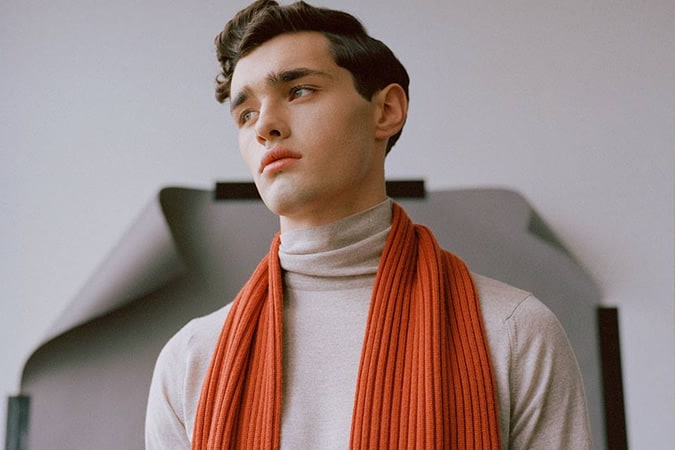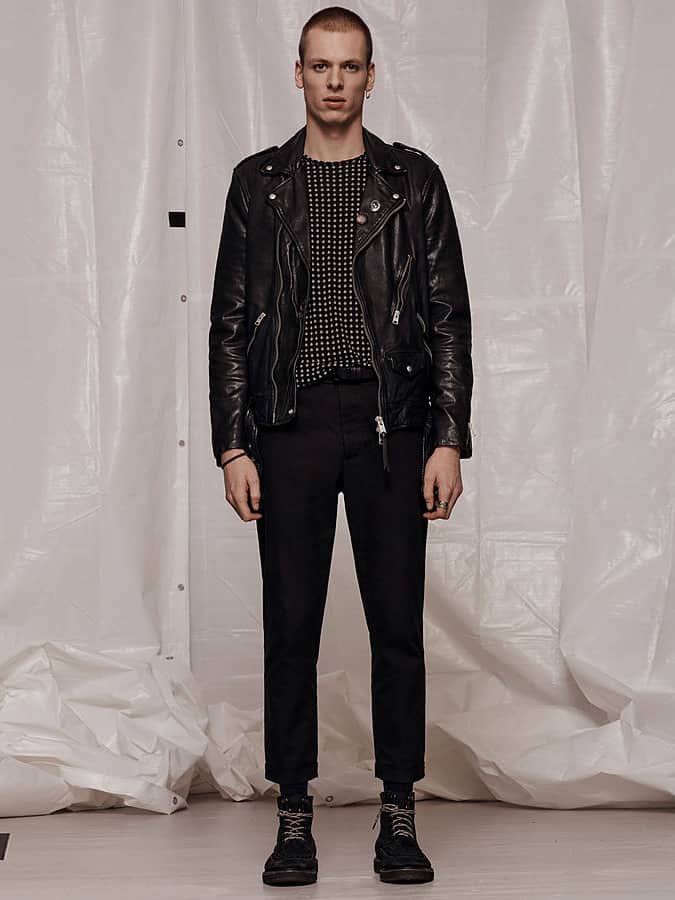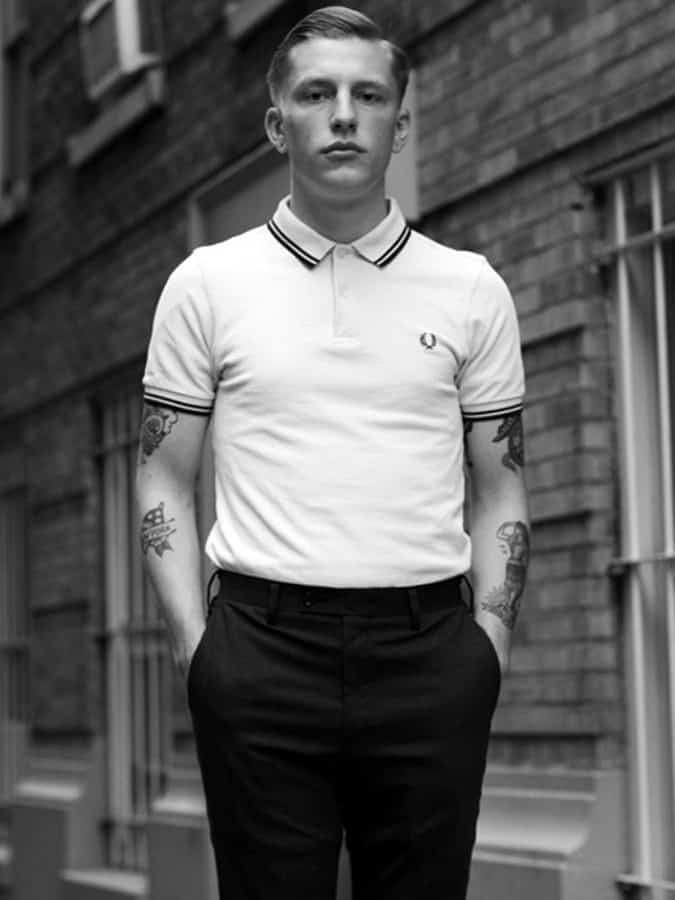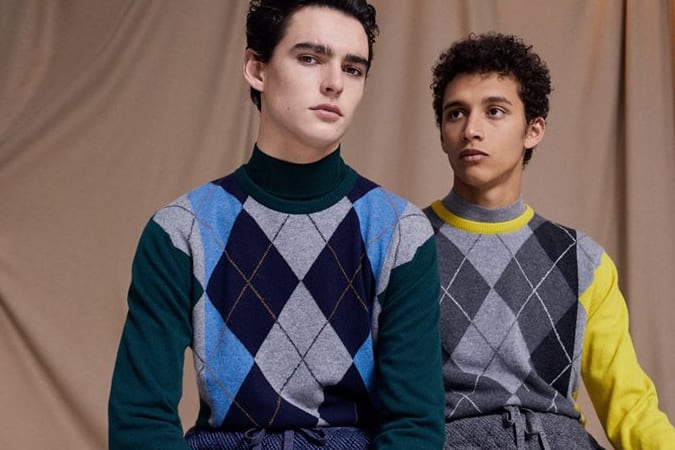We hate to toot our own horn, especially when this island nation isn’t in the most secure predicament at the moment, but when it comes to fashion, Britain punches far above its relatively small population. Edward VII and Hardy Amies, Vivienne Westwood and Paul Smith, David Gandy and David Beckham: there are pioneers and icons of menswear here to spare, but rather than give you an endless list of names, let’s take a whistle-stop tour of the trophy cabinet. From products first conceived and perfected on these shores, we move to the trends and movements that have helped define some of menswear’s most enduring looks before settling on the geographical places that any savvy consumer should go to restock their wardrobes. These are the heroes of British menswear, the pieces that have helped define not just fashion in this fair isle but the world over.
Great British Style Inventions
Harrington Jacket
The Harrington Jacket is a tale of two British menswear brands, Baracuta and Grenfell. It’s debated as to which one originally came up with the design, Baracuta having designed its G9 model, the OG Harrington, in 1939, while Grenfell supposedly came up with a rather similar lightweight golfing jacket earlier in the decade. Whichever one it was, this is a worthy victory for Britain, the waist length jacket having successfully stayed in the wardrobes of men the world over thanks to a flattering cut, simple block colouring that makes it easy to style (although a white tee and jeans a la James Dean is still the best) and an ingenious back yoke that allows water to run down the jacket leaving the wearer dry underneath.
 Baracuta
Baracuta
Running Shoes
While Adi Dassler, yeah the one who gave the first portion of his name to the monolithic German sportswear brand, can lay claim to having invented the modern interpretation of the running shoe, it was the Brits who came up with the primitive version. The inventor of these was Joseph William Foster, co-founder of the Boulton Company, later Reebok, who would later in an incestuous turn of events be owned by Adidas, who first had the bright idea of putting spikes on rubber plimsolls to help improve grip for early casual runners. Adi might have modernised it, but we won the race.
 Norman Walsh
Norman Walsh
Dinner Jacket
Nobody does it better than James Bond, of course, but somebody did do it before him – the future king of England. Back in the 1860s, when Edward VII was still the Prince of Wales, he asked his friend and tailor Henry Poole to design him a jacket to wear at dinner without the usual tails. The design went on to become the focal point for the entire black tie dress code (although the original was midnight blue). Known more commonly as a tuxedo in the US, designers are experimenting with the form today, but it barely changed in its first 150 years. Distinguished by satin or grosgrain lapels, worn with a bow tie and side-stripe trousers, it’s is the last word in dressing up.
 Henry Poole
Henry Poole
Desert Boots
This casual ankle boot actually has its origins overseas, where British Army units were said to wear they style. Brought back to the UK and popularised by Nathan Clark, the great grandson of James Clark (the founder of the high street shoe company), the style has been a wearable classic for more than half a century. One a crepe sole in a soft caramel-coloured suede, we challenge you to find a boot that is simultaneously more versatile or more comfortable.
 Clarks
Clarks
Polo Neck
The polo neck, sometimes called the turtleneck but really they’re the complete same thing, is so called because of the British polo players who started sporting them in the mid 19th century. Salty sea dogs and fishy fisherman also began to take on the style for its ability to keep the wearer warm in the most trying of conditions before British playwright Noel Coward brought the turtleneck to the consciousness of high society, the famous cad able to slip one on for comfort without losing any of his well-dressed style. Which is exactly why it’s remained so popular to this day, an easy to emulate style that works for all rungs of the societal ladder from the Hollywood A-listers to mere mortals.
 John Smedley
John Smedley
Wax Jacket
Lousy British weather has a lot to answer for, but not all of it’s bad. It forced textile designers to come up with ingenious ways to keep people from this country warm and dry and the wax jacket is a good example. Okay, so sailors have been waxing their outerwear since the times of ancient Egypt, but nobody made them look as good as British heritage brands like Barbour and Belstaff. Their signature designs, made for motorcycling and outdoor pursuits have lasted decades and today look just as good in the city as they do in the wilds of Britain.
 Barbour
Barbour
Brogues
Brogues may be at home on pretty much anyone’s feet these days, but in their formative years on the soles of Scotsmen and Irishmen, they were fence sitting shoes. Being neither smart nor casual they were stuck in footwear limbo and best suited for the great outdoors. A practical hiking boot of yore, if you will, the telltale perforations as much about getting water out as looking good. Today brogues have come in from the cold and are most often worn in formal settings, though they have that magic ability to dress up more casual leaning outfits without looking completely ridiculous. The magic must be in those perforations which add enough interest to have them welcomed into your off-duty wardrobe, but not enough to scare away your work tailoring. We love a good all-rounder.
 Crockett & Jones
Crockett & Jones
Rugby Shirt
The first rugby shirt was originally a collared dress shirt worn with a bow tie by its posh schoolboy players. The shirt gradually developed to meet the demands of the sport with the buttons taken off the front so they didn’t scratch the face of tacklers and a thick cotton jersey construction that suited the winter weather the sport was played in. That toned-down poshness meant the jersey perfectly encapsulated smart-casual style off the field of play, with preppy American students in the 1950s hijacking the top and making it a mainstay of the collegiate look, where it has stayed ever since. More recently, it’s been adopted the streetwear and skatewear camps, too.
 Gieves & Hawkes
Gieves & Hawkes
Three-Piece Suit
For today’s comfort over conformity generation, it’s easy to forget that the three-piece suit is one of the most revolutionary and resilient menswear heroes of all time. Before the suit, well-dressed men were all silk stockings, tailcoats and knee breeches, which presumably made getting ready in the morning a bloody hassle. You’ve got Beau Brummell to thank for the easy convenience of the suit as we know it today. Rejecting the fussy styles of the early 1800s, Brummell helped to popularise trousers that reached the ankles and a simple jacket and waistcoat to sit alongside it. Now, the three-piece suit may be only drawn upon for the most formal occasions or for those who are never knowingly underdressed. Either way, without it, you’d probably still be wearing stockings.
 Charles Tyrwhitt
Charles Tyrwhitt
Cardigan
The cardigan has gone up and down in the estimations of menswear enthusiasts. To some, it’s best left to your grandad, to others it’s one of the most versatile, smart-casual pieces in menswear, rocked by style icons as diverse as Kurt Cobain and Steve McQueen. The first cardigans were worn as wool waistcoats by British soldiers during the Crimean War, and it was the war’s hero the Earl of Cardigan who popularised the look and gave this menswear hero its name. We still enjoy this way of wearing them, as a less natty alternative to the waistcoat, but it was the way that Cobain and co wore them, chunky and oversized, that really brought the piece out of its mid-century retirement.
 Burton
Burton
Chelsea Boots
While the Chelsea boot is more closely associated with menswear these days, it was our dear Queen Victoria, who popularised the style, her personal cobbler J. Sparkes-Hall having designed the style as a more comfortable alternative to riding boots. The name didn’t come till a century later though when the ‘Chelsea set’ a group of high-falutin’ artists and socialites saw the boots as the perfect complement to their natty, off-kilter tailoring. They’ve since become the most reached-for shoe in the menswear wardrobe, the sleek shape following the silhouette of a contemporary slim pair of trousers or jeans perfectly for a marriage made in menswear heaven.
 Dr. Martens
Dr. Martens
Game-Changing Trends & Movements
Punk
Not a single menswear tribe is as indelibly linked to a musical subculture as closely as punk. Ripped jeans, leather jackets, and slogan tees were all major orchestrators in the musically driven movement that swept through the 1970s led by British band The Sex Pistols and more importantly their manager Malcolm McClaren and his for-a-time partner, the designer Vivienne Westwood. McClaren’s inspiration for the look actually came from the American singer Richard Hell (shhhh), but the impresario had the know-how to run back to Kings Road, London with the style under his arms and claim it for us Brits. The look is less in-your-face then back in the 70s but its counter-culture beginnings have meant its retained its place as a gritty alternative to the more uptight parts of British style.
 AllSaints
AllSaints
All Black Everything
As is the case with much of British sartorial history, the Royals came up with this one first. It was Queen Vic again who, upon the death of her husband Prince Albert, decreed that she would wear black everything, every day for the rest of her life. Less a style statement, more a touching tribute, this period ending up stretching to 40 years, proof that if we were ever forced to wear a colour for the rest of our life, black would be the safest and most stylish, although we’d personally go for the simple tee rather than a bonnet.
 Reiss
Reiss
Football Casuals
In the late ’70s and 80s, British football fans turned to sportswear for fashion at around the same time hip-hop culture was doing the same in the US. The British version was an eclectic mix of heritage brands (Fred Perry) and Italian imports (Sergio Tacchini, Stone Island). Terrace fashion had a lasting impact on menswear, not least in casuals’ devotion to Adidas trainers – sneakerheads 30 years before anyone came up with that term – and the fact that sportswear could be luxury.
 Fred Perry
Fred Perry
Turned Up Trousers
It’s one of the oldest tricks in the menswear book, and one first created for wholly practical reasons as the ever-stylish King Edward VII first came up with the genius idea of turning up the hems of his trousers in bad weather so that they wouldn’t get muddy. As well as dirt prevention, a turn-up will also prevent unsightly bunches from collecting around your ankles, will create a much-needed visual break on gangly limbs and will, of course, show off any dandy footwear you’re wearing. And it’s all thanks to King Eddie.
 King & Tuckfield
King & Tuckfield
Sartorialism
Twelve years ago the way men dressed practically changed overnight, when Mad Men aired for the first time. With it, great swathes of the male population had their eyes opened to tailoring as a style choice, not something imposed by office dress rules. Pocket square sales went through the roof, and slim ties became the new norm for office workers everywhere. Now, Don Draper was American, but the style it inspired was a particularly British take on tailoring, with precise lines and unwavering formality the standout characteristics. Around the same time Instagram came along, prompting wannabe David Gandys to share their buttoned up OOTDs, complete with tie bars and the appropriate hashtags. Since then, tailoring has entered a new, more casual phase – relaxed suits with T-shirts and trainers are here to stay. But it’ll always be rooted in the old school and we wouldn’t be surprised if the tie makes a comeback any day now.
 Gieves & Hawkes
Gieves & Hawkes
Menswear Hubs
Northampton Shoes
On first sight, there’s not much to the Midlands town of Northampton. There is a lovely church and a good rugby club side, but so far, so non-descript. That’s until you find out that this market town and the surrounding region is actually the shoemaking capital of the world with some of the world’s most iconic and high-quality shoe brands – Dr. Martens, Grenson, Cheaney, Crockett & Jones, John Lobb – having their origins there. There’s something in the water, quite literally, with the town’s proximity to 11 rivers encouraging the industry to flock to the town as well as the abundance of oak bark for tanning the shoe leather in the forests of Northamptonshire. Expect three things from a Northampton shoe – high-end luxury, hand made quality and classic silhouettes – three features that have made the town an enduring part of the footwear and fashion industry as a whole.
 Grenson
Grenson
Savile Row Tailoring
There’s only one road that’s synonymous with tailoring in the world: Savile Row. From Gieves & Hawkes to Huntsman, numerous prestigious houses call this corner of London’s Mayfair home and have done since the 19th century. The Row even has a style of its own that has become shorthand proper formal suiting: straight lines, stiff canvas, padded shoulders. It’s loosening up these days but whatever your taste, if you’re looking for bespoke tailoring or a made-to-measure suit, there’s nowhere better.
 Huntsman
Huntsman
Scottish Knitwear
Smoked salmon, whisky, five-star hotels – the Scottish really know how to perfect the finer things in life, although we’d give the deep fried Mars bars a miss. Knitwear is intertwined with the culture of the country, and more specifically the finest of all knits, cashmere, the epicentre of the industry being Hawick, 50 miles south of Edinburgh. Knitwear brands Pringle and Lyle & Scott are the two most famous sons of the town, the former having popularised the Argyle, a diamond patterned jumper named and based on the tartan of Clan Campbell from the Scottish town of the same name. French luxury brand Chanel also own a knitwear mill in the area, but why the area ever become a hub is confusing. Cashmere goats that provide the fabric are native to most of Asia, some few thousand miles away. Rather it’s the first knitting machines that were brought to Scotland in the mid-18th century and the way the locals perfected the use of them that explains the nations standing as true experts in this king of all clothing materials.
 Pringle
Pringle
Jermyn Street Shirts
Some tailors do make their own shirts, but most rely on dedicated shirtmakers to draw them up. And most of the best in the UK are located on one road – Jermyn Street. Here you’ll find Turnbull & Asser, Emma Willis and Emmett shirts, among others, and T.M. Lewin even started out there. There’s nowhere better for dress shirts or casual linen options especially.
 Emma Willis
Emma Willis







